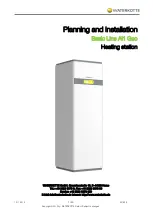
12
After opening the device:
-
Discharge all electrically charged components
-
Ensure that all components are disconnected from the power supply
If work is needed on voltage-carrying parts, bring in a second person who will switch off the
main switch at the correct time.
Stray Welding
Currents
If the following instructions are not observed, stray welding currents may occur, which pose
a risk of the following:
-
Fire
-
Overheating of components connected to the workpiece
-
Destruction of ground conductors
-
Damage to the device and other electrical equipment
Ensure that the workpiece terminal is securely connected to the workpiece.
Secure the workpiece terminal as close to the spot to be welded as possible.
If the floor is electrically conductive, ensure that there is sufficient insulation between the
device and the floor.
Observe the following when using electrical distributors, double-headed retainers, etc.:
Even the electrode of the welding torch/electrode holder not in use carries electric poten
-
tial. Ensure that there is sufficient insulation when the unused welding torch/electrode hold
-
er is stored.
In automated MIG/MAG applications, only guide the wire electrode from the welding wire
drum, large spool or wirespool to the wirefeeder with insulation.
EMC Device Clas
-
sifications
Devices in emission class A:
-
Are only designed for use in industrial settings
-
Can cause line-bound and radiated interference in other areas
Devices in emission class B:
-
Satisfy the emissions criteria for residential and industrial areas. This is also true for
residential areas in which the energy is supplied from the public low-voltage grid.
EMC device classification as per the rating plate or technical data.
EMC Measures
In certain cases, even though a device complies with the standard limit values for emis
-
sions, it may affect the application area for which it was designed (e.g., when there is sen
-
sitive equipment at the same location, or if the site where the device is installed is close to
either radio or television receivers).
If this is the case, then the operating company is obliged to take appropriate action to rectify
the situation.
Test and assess the immunity of equipment in the vicinity of the device in accordance with
national and international provisions. Examples of interference-prone equipment that could
be affected by the device:
-
Safety devices
-
Grid power lines, signal lines and data transfer lines
-
EMC and telecommunications equipment
-
Devices for measuring and calibrating
Summary of Contents for TransTig 170
Page 2: ...2...
Page 6: ...6...
Page 18: ...18...
Page 19: ...General Information...
Page 20: ......
Page 24: ...24...
Page 25: ...Operating controls and connections...
Page 26: ......
Page 33: ...Installation and Startup...
Page 34: ......
Page 41: ...Welding Mode...
Page 42: ......
Page 62: ...62...
Page 63: ...Setup Settings...
Page 64: ......
Page 79: ...Troubleshooting and Maintenance...
Page 80: ......
Page 88: ...88...
Page 89: ...Appendix...
Page 90: ......
Page 92: ...92 Safety symbol S Max shielding gas pressure 5 bar 73 psi Noise emissions LWA 68 0 dB A...
Page 98: ......
Page 99: ......













































